NSC2500: Lay Article on Gout and Corticosteroids for Public Health
VerifiedAdded on 2022/09/03
|10
|2186
|22
Report
AI Summary
This report, prepared for the NSC2500 course, explores gout, an inflammatory disease characterized by excessive uric acid levels. It details the normal physiology of uric acid production and metabolism, followed by a comprehensive explanation of the pathophysiology of gout, including the role of hyperuricemia, urate crystal formation, and immune system activation. The report then focuses on the pharmacology of corticosteroids, specifically glucocorticoids like prednisone and triamcinolone, outlining their mechanism of action in reducing inflammation and suppressing immune responses. It covers the metabolic effects of corticosteroids, including potential adverse effects such as Cushing's syndrome, and contraindications for their use in certain patient populations. The report emphasizes the importance of lifestyle interventions and other medications in the management of gout and concludes with a discussion of the disease's public health implications. The target audience is males aged 30 to 60 who consume alcohol and who have gout or are at risk of developing it. The report also includes a detailed abstract and a list of relevant references.
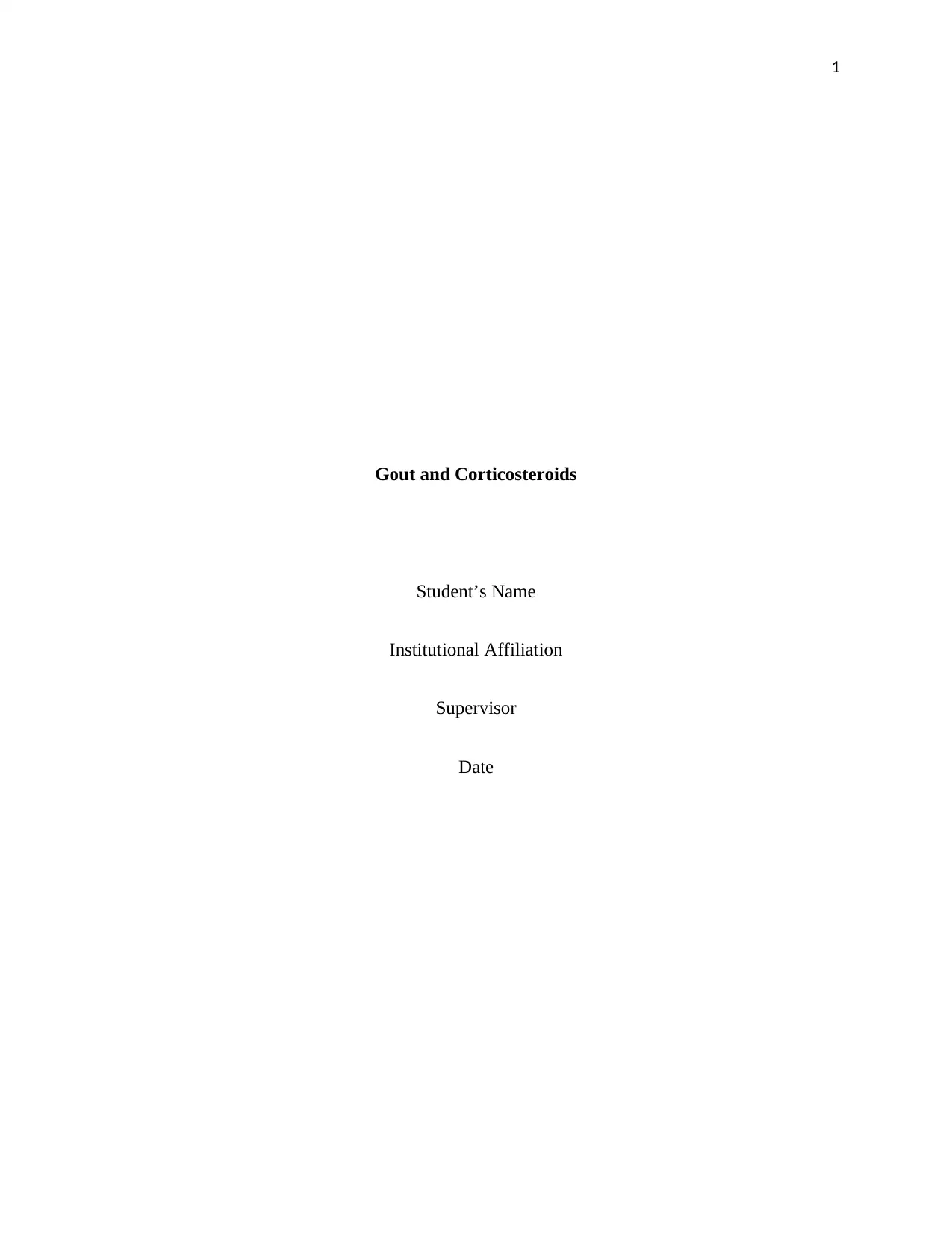
1
Gout and Corticosteroids
Student’s Name
Institutional Affiliation
Supervisor
Date
Gout and Corticosteroids
Student’s Name
Institutional Affiliation
Supervisor
Date
Paraphrase This Document
Need a fresh take? Get an instant paraphrase of this document with our AI Paraphraser
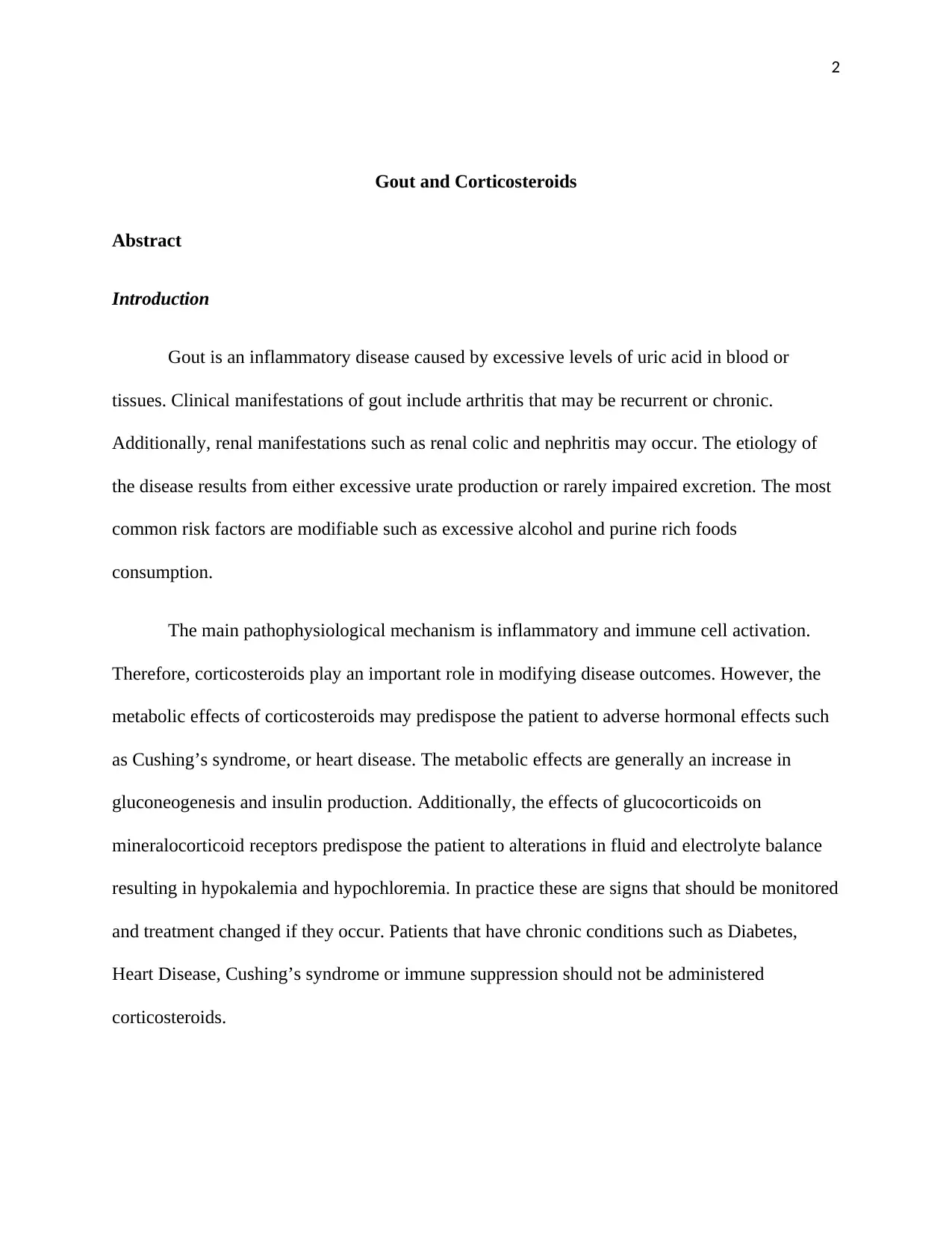
2
Gout and Corticosteroids
Abstract
Introduction
Gout is an inflammatory disease caused by excessive levels of uric acid in blood or
tissues. Clinical manifestations of gout include arthritis that may be recurrent or chronic.
Additionally, renal manifestations such as renal colic and nephritis may occur. The etiology of
the disease results from either excessive urate production or rarely impaired excretion. The most
common risk factors are modifiable such as excessive alcohol and purine rich foods
consumption.
The main pathophysiological mechanism is inflammatory and immune cell activation.
Therefore, corticosteroids play an important role in modifying disease outcomes. However, the
metabolic effects of corticosteroids may predispose the patient to adverse hormonal effects such
as Cushing’s syndrome, or heart disease. The metabolic effects are generally an increase in
gluconeogenesis and insulin production. Additionally, the effects of glucocorticoids on
mineralocorticoid receptors predispose the patient to alterations in fluid and electrolyte balance
resulting in hypokalemia and hypochloremia. In practice these are signs that should be monitored
and treatment changed if they occur. Patients that have chronic conditions such as Diabetes,
Heart Disease, Cushing’s syndrome or immune suppression should not be administered
corticosteroids.
Gout and Corticosteroids
Abstract
Introduction
Gout is an inflammatory disease caused by excessive levels of uric acid in blood or
tissues. Clinical manifestations of gout include arthritis that may be recurrent or chronic.
Additionally, renal manifestations such as renal colic and nephritis may occur. The etiology of
the disease results from either excessive urate production or rarely impaired excretion. The most
common risk factors are modifiable such as excessive alcohol and purine rich foods
consumption.
The main pathophysiological mechanism is inflammatory and immune cell activation.
Therefore, corticosteroids play an important role in modifying disease outcomes. However, the
metabolic effects of corticosteroids may predispose the patient to adverse hormonal effects such
as Cushing’s syndrome, or heart disease. The metabolic effects are generally an increase in
gluconeogenesis and insulin production. Additionally, the effects of glucocorticoids on
mineralocorticoid receptors predispose the patient to alterations in fluid and electrolyte balance
resulting in hypokalemia and hypochloremia. In practice these are signs that should be monitored
and treatment changed if they occur. Patients that have chronic conditions such as Diabetes,
Heart Disease, Cushing’s syndrome or immune suppression should not be administered
corticosteroids.
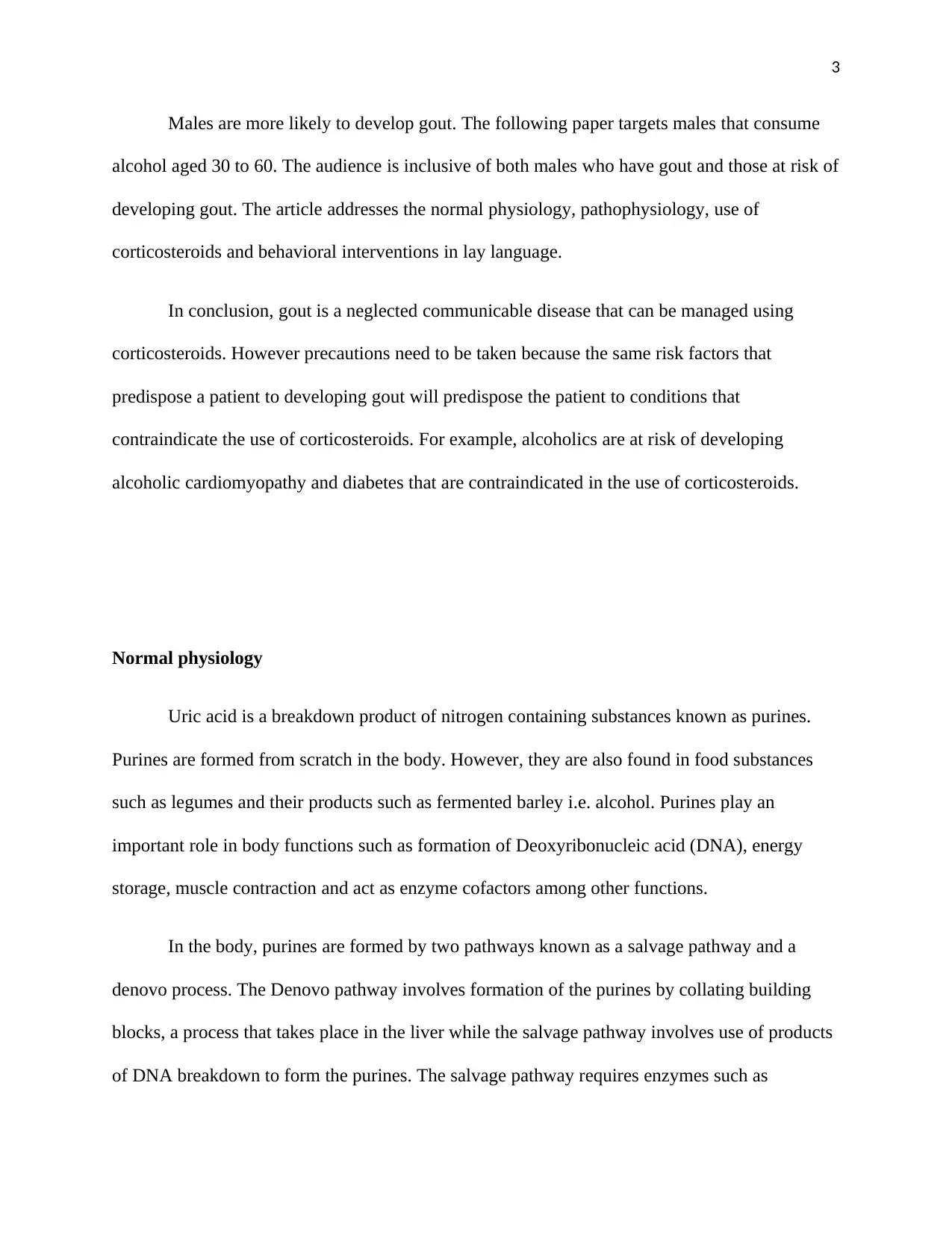
3
Males are more likely to develop gout. The following paper targets males that consume
alcohol aged 30 to 60. The audience is inclusive of both males who have gout and those at risk of
developing gout. The article addresses the normal physiology, pathophysiology, use of
corticosteroids and behavioral interventions in lay language.
In conclusion, gout is a neglected communicable disease that can be managed using
corticosteroids. However precautions need to be taken because the same risk factors that
predispose a patient to developing gout will predispose the patient to conditions that
contraindicate the use of corticosteroids. For example, alcoholics are at risk of developing
alcoholic cardiomyopathy and diabetes that are contraindicated in the use of corticosteroids.
Normal physiology
Uric acid is a breakdown product of nitrogen containing substances known as purines.
Purines are formed from scratch in the body. However, they are also found in food substances
such as legumes and their products such as fermented barley i.e. alcohol. Purines play an
important role in body functions such as formation of Deoxyribonucleic acid (DNA), energy
storage, muscle contraction and act as enzyme cofactors among other functions.
In the body, purines are formed by two pathways known as a salvage pathway and a
denovo process. The Denovo pathway involves formation of the purines by collating building
blocks, a process that takes place in the liver while the salvage pathway involves use of products
of DNA breakdown to form the purines. The salvage pathway requires enzymes such as
Males are more likely to develop gout. The following paper targets males that consume
alcohol aged 30 to 60. The audience is inclusive of both males who have gout and those at risk of
developing gout. The article addresses the normal physiology, pathophysiology, use of
corticosteroids and behavioral interventions in lay language.
In conclusion, gout is a neglected communicable disease that can be managed using
corticosteroids. However precautions need to be taken because the same risk factors that
predispose a patient to developing gout will predispose the patient to conditions that
contraindicate the use of corticosteroids. For example, alcoholics are at risk of developing
alcoholic cardiomyopathy and diabetes that are contraindicated in the use of corticosteroids.
Normal physiology
Uric acid is a breakdown product of nitrogen containing substances known as purines.
Purines are formed from scratch in the body. However, they are also found in food substances
such as legumes and their products such as fermented barley i.e. alcohol. Purines play an
important role in body functions such as formation of Deoxyribonucleic acid (DNA), energy
storage, muscle contraction and act as enzyme cofactors among other functions.
In the body, purines are formed by two pathways known as a salvage pathway and a
denovo process. The Denovo pathway involves formation of the purines by collating building
blocks, a process that takes place in the liver while the salvage pathway involves use of products
of DNA breakdown to form the purines. The salvage pathway requires enzymes such as
⊘ This is a preview!⊘
Do you want full access?
Subscribe today to unlock all pages.

Trusted by 1+ million students worldwide
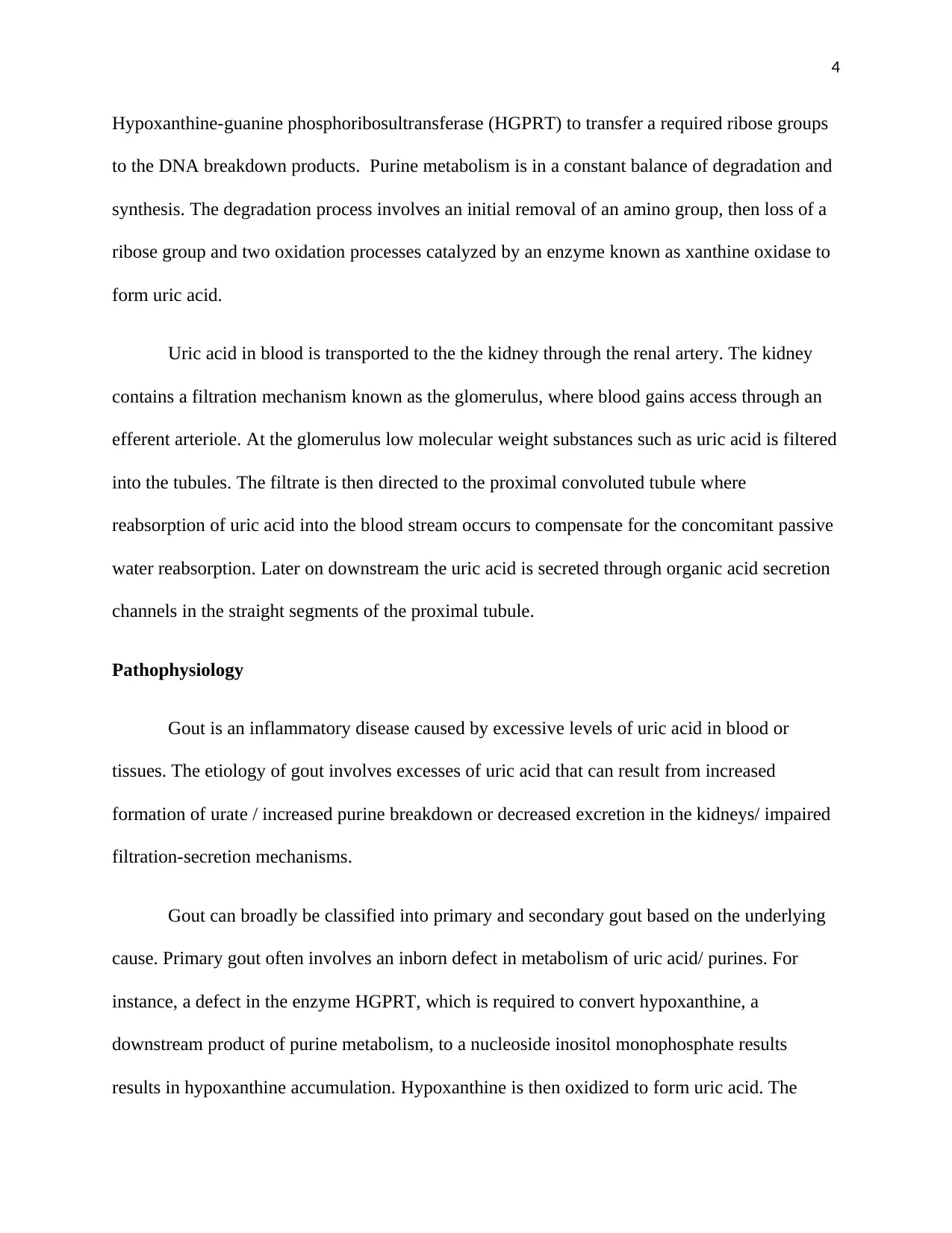
4
Hypoxanthine-guanine phosphoribosultransferase (HGPRT) to transfer a required ribose groups
to the DNA breakdown products. Purine metabolism is in a constant balance of degradation and
synthesis. The degradation process involves an initial removal of an amino group, then loss of a
ribose group and two oxidation processes catalyzed by an enzyme known as xanthine oxidase to
form uric acid.
Uric acid in blood is transported to the the kidney through the renal artery. The kidney
contains a filtration mechanism known as the glomerulus, where blood gains access through an
efferent arteriole. At the glomerulus low molecular weight substances such as uric acid is filtered
into the tubules. The filtrate is then directed to the proximal convoluted tubule where
reabsorption of uric acid into the blood stream occurs to compensate for the concomitant passive
water reabsorption. Later on downstream the uric acid is secreted through organic acid secretion
channels in the straight segments of the proximal tubule.
Pathophysiology
Gout is an inflammatory disease caused by excessive levels of uric acid in blood or
tissues. The etiology of gout involves excesses of uric acid that can result from increased
formation of urate / increased purine breakdown or decreased excretion in the kidneys/ impaired
filtration-secretion mechanisms.
Gout can broadly be classified into primary and secondary gout based on the underlying
cause. Primary gout often involves an inborn defect in metabolism of uric acid/ purines. For
instance, a defect in the enzyme HGPRT, which is required to convert hypoxanthine, a
downstream product of purine metabolism, to a nucleoside inositol monophosphate results
results in hypoxanthine accumulation. Hypoxanthine is then oxidized to form uric acid. The
Hypoxanthine-guanine phosphoribosultransferase (HGPRT) to transfer a required ribose groups
to the DNA breakdown products. Purine metabolism is in a constant balance of degradation and
synthesis. The degradation process involves an initial removal of an amino group, then loss of a
ribose group and two oxidation processes catalyzed by an enzyme known as xanthine oxidase to
form uric acid.
Uric acid in blood is transported to the the kidney through the renal artery. The kidney
contains a filtration mechanism known as the glomerulus, where blood gains access through an
efferent arteriole. At the glomerulus low molecular weight substances such as uric acid is filtered
into the tubules. The filtrate is then directed to the proximal convoluted tubule where
reabsorption of uric acid into the blood stream occurs to compensate for the concomitant passive
water reabsorption. Later on downstream the uric acid is secreted through organic acid secretion
channels in the straight segments of the proximal tubule.
Pathophysiology
Gout is an inflammatory disease caused by excessive levels of uric acid in blood or
tissues. The etiology of gout involves excesses of uric acid that can result from increased
formation of urate / increased purine breakdown or decreased excretion in the kidneys/ impaired
filtration-secretion mechanisms.
Gout can broadly be classified into primary and secondary gout based on the underlying
cause. Primary gout often involves an inborn defect in metabolism of uric acid/ purines. For
instance, a defect in the enzyme HGPRT, which is required to convert hypoxanthine, a
downstream product of purine metabolism, to a nucleoside inositol monophosphate results
results in hypoxanthine accumulation. Hypoxanthine is then oxidized to form uric acid. The
Paraphrase This Document
Need a fresh take? Get an instant paraphrase of this document with our AI Paraphraser
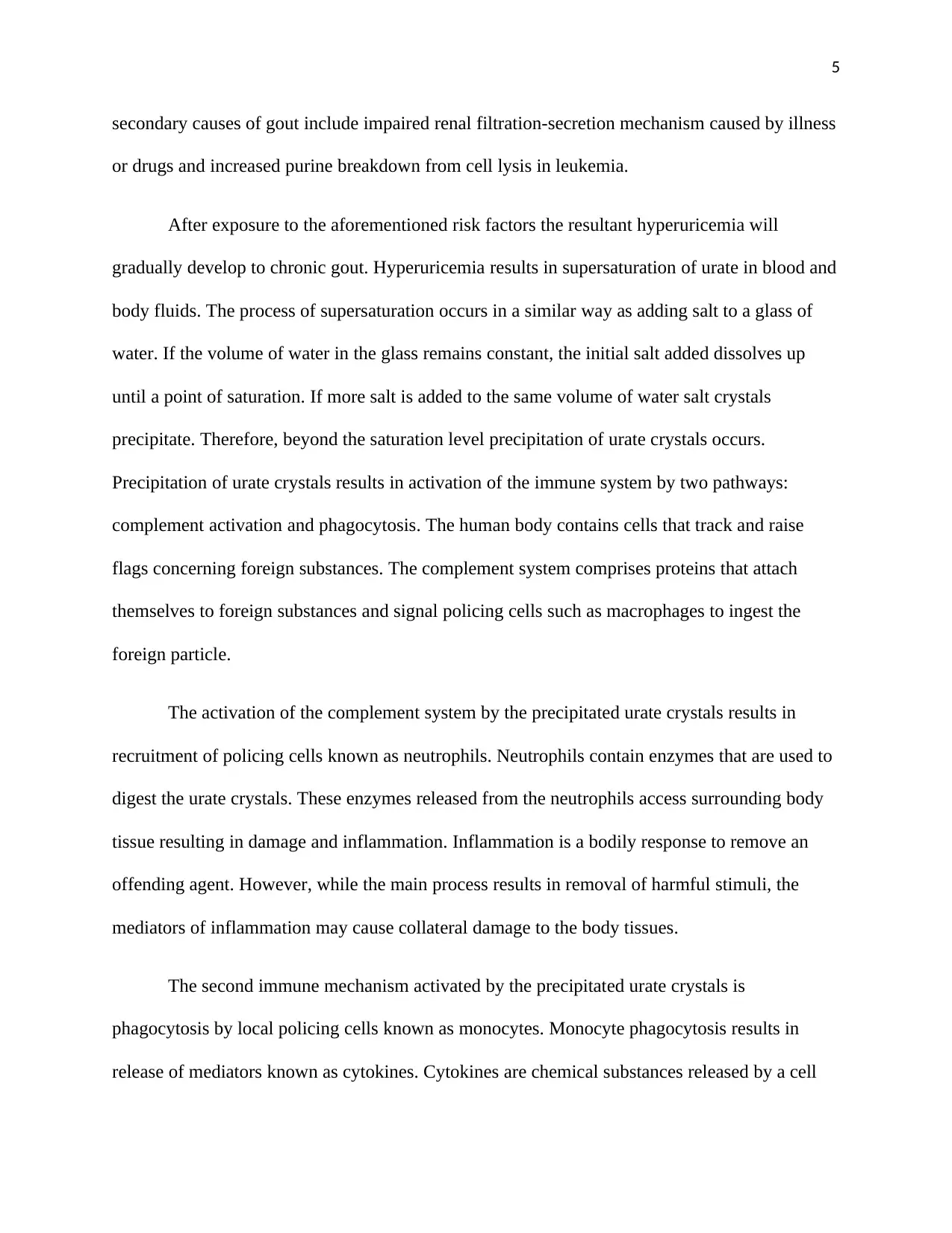
5
secondary causes of gout include impaired renal filtration-secretion mechanism caused by illness
or drugs and increased purine breakdown from cell lysis in leukemia.
After exposure to the aforementioned risk factors the resultant hyperuricemia will
gradually develop to chronic gout. Hyperuricemia results in supersaturation of urate in blood and
body fluids. The process of supersaturation occurs in a similar way as adding salt to a glass of
water. If the volume of water in the glass remains constant, the initial salt added dissolves up
until a point of saturation. If more salt is added to the same volume of water salt crystals
precipitate. Therefore, beyond the saturation level precipitation of urate crystals occurs.
Precipitation of urate crystals results in activation of the immune system by two pathways:
complement activation and phagocytosis. The human body contains cells that track and raise
flags concerning foreign substances. The complement system comprises proteins that attach
themselves to foreign substances and signal policing cells such as macrophages to ingest the
foreign particle.
The activation of the complement system by the precipitated urate crystals results in
recruitment of policing cells known as neutrophils. Neutrophils contain enzymes that are used to
digest the urate crystals. These enzymes released from the neutrophils access surrounding body
tissue resulting in damage and inflammation. Inflammation is a bodily response to remove an
offending agent. However, while the main process results in removal of harmful stimuli, the
mediators of inflammation may cause collateral damage to the body tissues.
The second immune mechanism activated by the precipitated urate crystals is
phagocytosis by local policing cells known as monocytes. Monocyte phagocytosis results in
release of mediators known as cytokines. Cytokines are chemical substances released by a cell
secondary causes of gout include impaired renal filtration-secretion mechanism caused by illness
or drugs and increased purine breakdown from cell lysis in leukemia.
After exposure to the aforementioned risk factors the resultant hyperuricemia will
gradually develop to chronic gout. Hyperuricemia results in supersaturation of urate in blood and
body fluids. The process of supersaturation occurs in a similar way as adding salt to a glass of
water. If the volume of water in the glass remains constant, the initial salt added dissolves up
until a point of saturation. If more salt is added to the same volume of water salt crystals
precipitate. Therefore, beyond the saturation level precipitation of urate crystals occurs.
Precipitation of urate crystals results in activation of the immune system by two pathways:
complement activation and phagocytosis. The human body contains cells that track and raise
flags concerning foreign substances. The complement system comprises proteins that attach
themselves to foreign substances and signal policing cells such as macrophages to ingest the
foreign particle.
The activation of the complement system by the precipitated urate crystals results in
recruitment of policing cells known as neutrophils. Neutrophils contain enzymes that are used to
digest the urate crystals. These enzymes released from the neutrophils access surrounding body
tissue resulting in damage and inflammation. Inflammation is a bodily response to remove an
offending agent. However, while the main process results in removal of harmful stimuli, the
mediators of inflammation may cause collateral damage to the body tissues.
The second immune mechanism activated by the precipitated urate crystals is
phagocytosis by local policing cells known as monocytes. Monocyte phagocytosis results in
release of mediators known as cytokines. Cytokines are chemical substances released by a cell
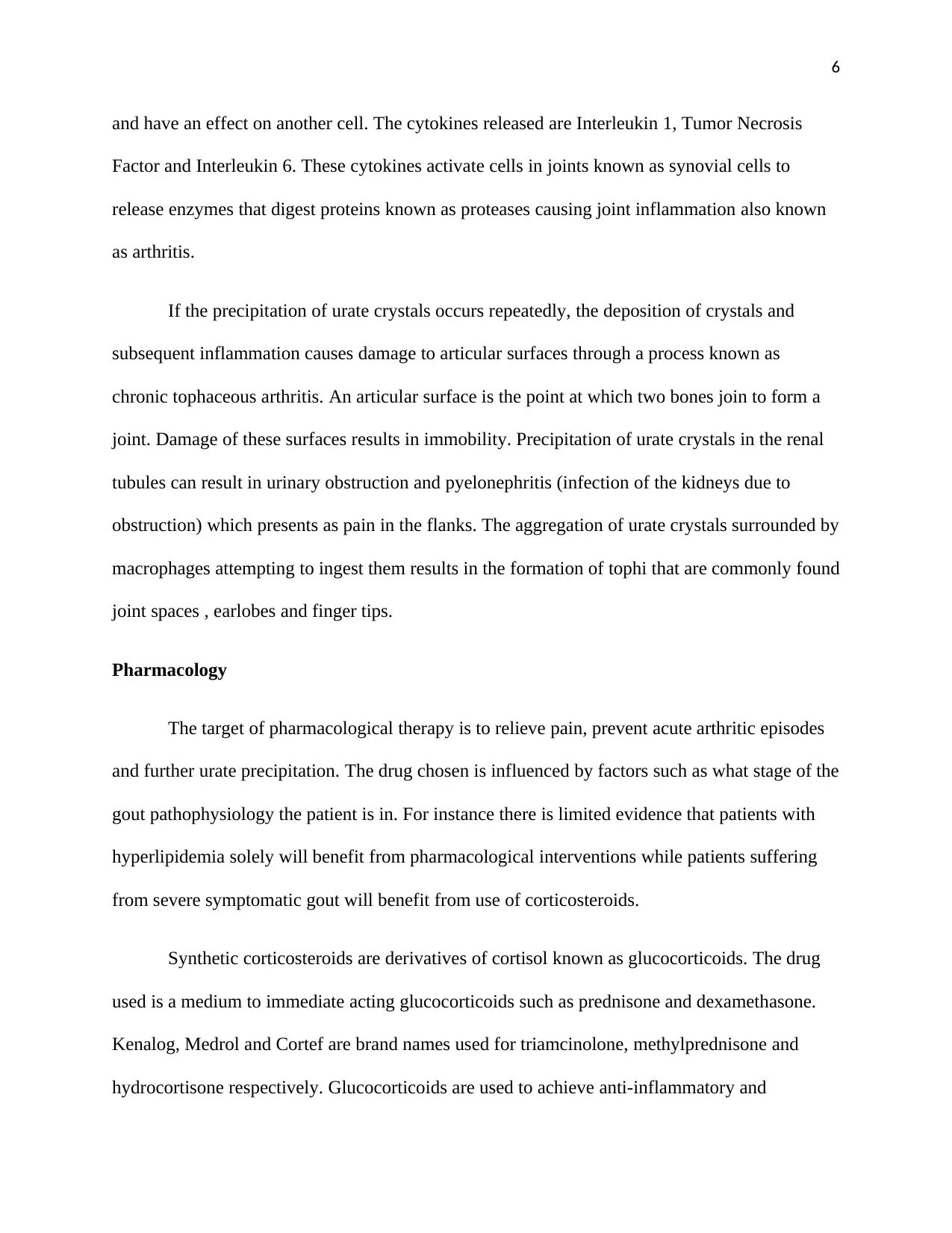
6
and have an effect on another cell. The cytokines released are Interleukin 1, Tumor Necrosis
Factor and Interleukin 6. These cytokines activate cells in joints known as synovial cells to
release enzymes that digest proteins known as proteases causing joint inflammation also known
as arthritis.
If the precipitation of urate crystals occurs repeatedly, the deposition of crystals and
subsequent inflammation causes damage to articular surfaces through a process known as
chronic tophaceous arthritis. An articular surface is the point at which two bones join to form a
joint. Damage of these surfaces results in immobility. Precipitation of urate crystals in the renal
tubules can result in urinary obstruction and pyelonephritis (infection of the kidneys due to
obstruction) which presents as pain in the flanks. The aggregation of urate crystals surrounded by
macrophages attempting to ingest them results in the formation of tophi that are commonly found
joint spaces , earlobes and finger tips.
Pharmacology
The target of pharmacological therapy is to relieve pain, prevent acute arthritic episodes
and further urate precipitation. The drug chosen is influenced by factors such as what stage of the
gout pathophysiology the patient is in. For instance there is limited evidence that patients with
hyperlipidemia solely will benefit from pharmacological interventions while patients suffering
from severe symptomatic gout will benefit from use of corticosteroids.
Synthetic corticosteroids are derivatives of cortisol known as glucocorticoids. The drug
used is a medium to immediate acting glucocorticoids such as prednisone and dexamethasone.
Kenalog, Medrol and Cortef are brand names used for triamcinolone, methylprednisone and
hydrocortisone respectively. Glucocorticoids are used to achieve anti-inflammatory and
and have an effect on another cell. The cytokines released are Interleukin 1, Tumor Necrosis
Factor and Interleukin 6. These cytokines activate cells in joints known as synovial cells to
release enzymes that digest proteins known as proteases causing joint inflammation also known
as arthritis.
If the precipitation of urate crystals occurs repeatedly, the deposition of crystals and
subsequent inflammation causes damage to articular surfaces through a process known as
chronic tophaceous arthritis. An articular surface is the point at which two bones join to form a
joint. Damage of these surfaces results in immobility. Precipitation of urate crystals in the renal
tubules can result in urinary obstruction and pyelonephritis (infection of the kidneys due to
obstruction) which presents as pain in the flanks. The aggregation of urate crystals surrounded by
macrophages attempting to ingest them results in the formation of tophi that are commonly found
joint spaces , earlobes and finger tips.
Pharmacology
The target of pharmacological therapy is to relieve pain, prevent acute arthritic episodes
and further urate precipitation. The drug chosen is influenced by factors such as what stage of the
gout pathophysiology the patient is in. For instance there is limited evidence that patients with
hyperlipidemia solely will benefit from pharmacological interventions while patients suffering
from severe symptomatic gout will benefit from use of corticosteroids.
Synthetic corticosteroids are derivatives of cortisol known as glucocorticoids. The drug
used is a medium to immediate acting glucocorticoids such as prednisone and dexamethasone.
Kenalog, Medrol and Cortef are brand names used for triamcinolone, methylprednisone and
hydrocortisone respectively. Glucocorticoids are used to achieve anti-inflammatory and
⊘ This is a preview!⊘
Do you want full access?
Subscribe today to unlock all pages.

Trusted by 1+ million students worldwide
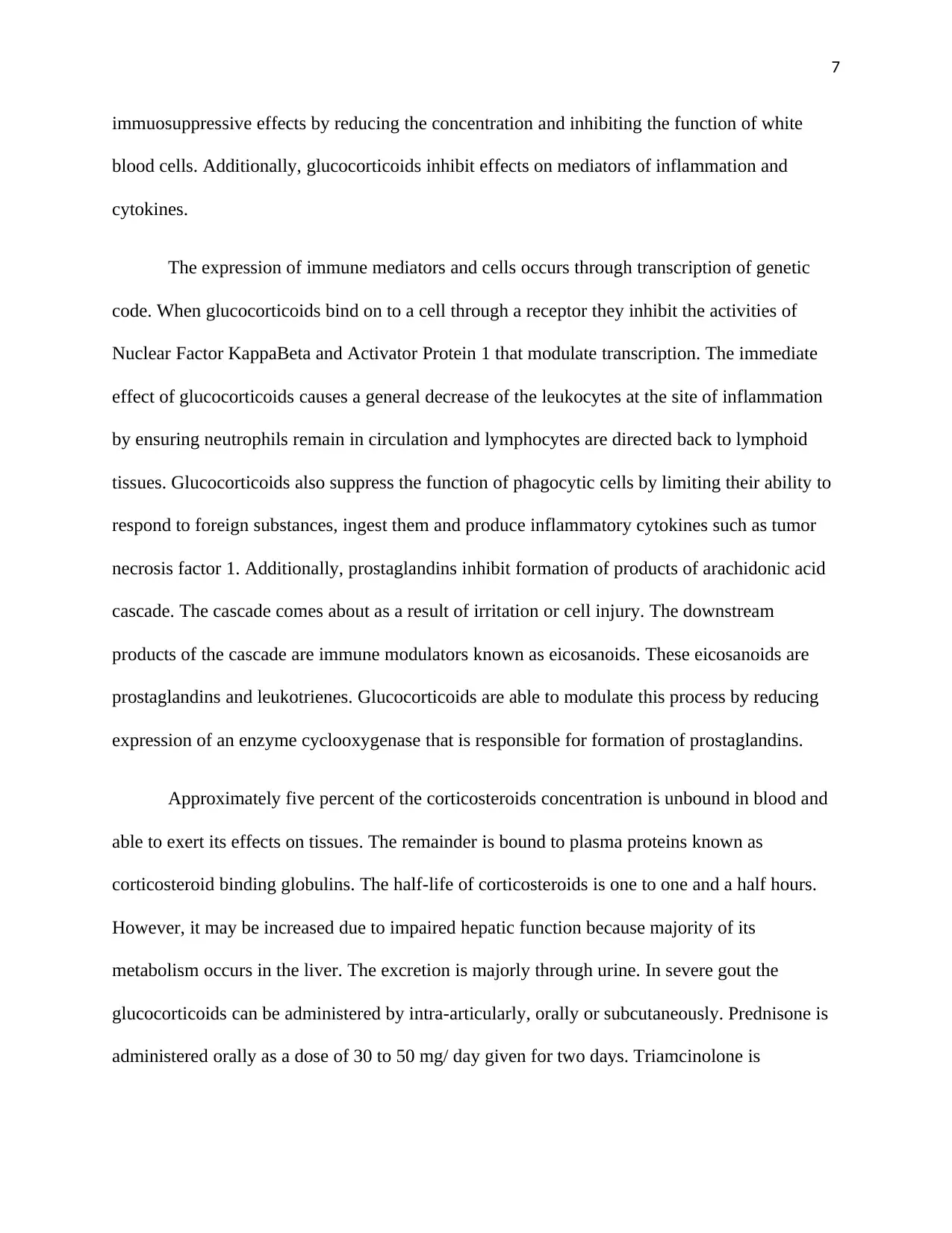
7
immuosuppressive effects by reducing the concentration and inhibiting the function of white
blood cells. Additionally, glucocorticoids inhibit effects on mediators of inflammation and
cytokines.
The expression of immune mediators and cells occurs through transcription of genetic
code. When glucocorticoids bind on to a cell through a receptor they inhibit the activities of
Nuclear Factor KappaBeta and Activator Protein 1 that modulate transcription. The immediate
effect of glucocorticoids causes a general decrease of the leukocytes at the site of inflammation
by ensuring neutrophils remain in circulation and lymphocytes are directed back to lymphoid
tissues. Glucocorticoids also suppress the function of phagocytic cells by limiting their ability to
respond to foreign substances, ingest them and produce inflammatory cytokines such as tumor
necrosis factor 1. Additionally, prostaglandins inhibit formation of products of arachidonic acid
cascade. The cascade comes about as a result of irritation or cell injury. The downstream
products of the cascade are immune modulators known as eicosanoids. These eicosanoids are
prostaglandins and leukotrienes. Glucocorticoids are able to modulate this process by reducing
expression of an enzyme cyclooxygenase that is responsible for formation of prostaglandins.
Approximately five percent of the corticosteroids concentration is unbound in blood and
able to exert its effects on tissues. The remainder is bound to plasma proteins known as
corticosteroid binding globulins. The half-life of corticosteroids is one to one and a half hours.
However, it may be increased due to impaired hepatic function because majority of its
metabolism occurs in the liver. The excretion is majorly through urine. In severe gout the
glucocorticoids can be administered by intra-articularly, orally or subcutaneously. Prednisone is
administered orally as a dose of 30 to 50 mg/ day given for two days. Triamcinolone is
immuosuppressive effects by reducing the concentration and inhibiting the function of white
blood cells. Additionally, glucocorticoids inhibit effects on mediators of inflammation and
cytokines.
The expression of immune mediators and cells occurs through transcription of genetic
code. When glucocorticoids bind on to a cell through a receptor they inhibit the activities of
Nuclear Factor KappaBeta and Activator Protein 1 that modulate transcription. The immediate
effect of glucocorticoids causes a general decrease of the leukocytes at the site of inflammation
by ensuring neutrophils remain in circulation and lymphocytes are directed back to lymphoid
tissues. Glucocorticoids also suppress the function of phagocytic cells by limiting their ability to
respond to foreign substances, ingest them and produce inflammatory cytokines such as tumor
necrosis factor 1. Additionally, prostaglandins inhibit formation of products of arachidonic acid
cascade. The cascade comes about as a result of irritation or cell injury. The downstream
products of the cascade are immune modulators known as eicosanoids. These eicosanoids are
prostaglandins and leukotrienes. Glucocorticoids are able to modulate this process by reducing
expression of an enzyme cyclooxygenase that is responsible for formation of prostaglandins.
Approximately five percent of the corticosteroids concentration is unbound in blood and
able to exert its effects on tissues. The remainder is bound to plasma proteins known as
corticosteroid binding globulins. The half-life of corticosteroids is one to one and a half hours.
However, it may be increased due to impaired hepatic function because majority of its
metabolism occurs in the liver. The excretion is majorly through urine. In severe gout the
glucocorticoids can be administered by intra-articularly, orally or subcutaneously. Prednisone is
administered orally as a dose of 30 to 50 mg/ day given for two days. Triamcinolone is
Paraphrase This Document
Need a fresh take? Get an instant paraphrase of this document with our AI Paraphraser
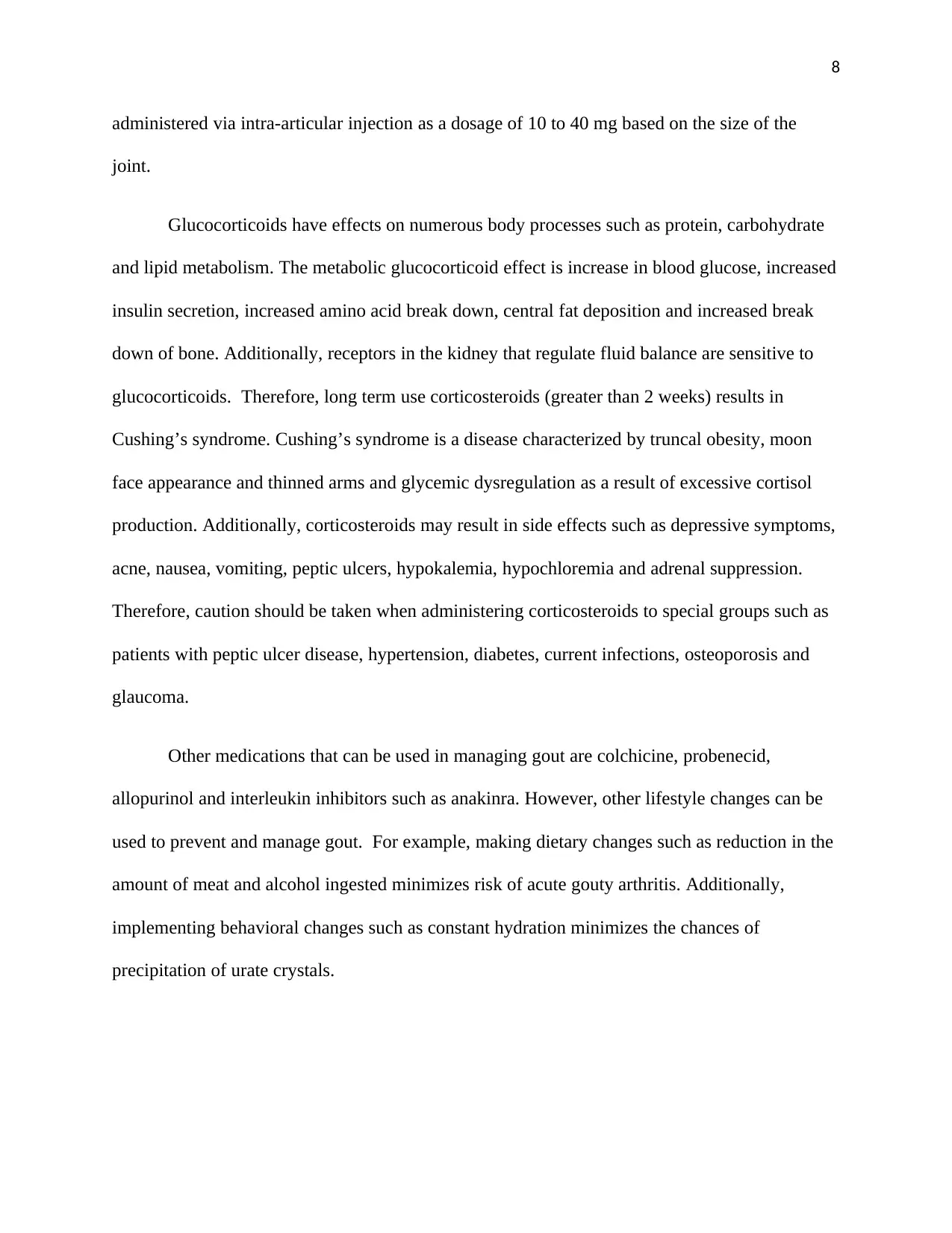
8
administered via intra-articular injection as a dosage of 10 to 40 mg based on the size of the
joint.
Glucocorticoids have effects on numerous body processes such as protein, carbohydrate
and lipid metabolism. The metabolic glucocorticoid effect is increase in blood glucose, increased
insulin secretion, increased amino acid break down, central fat deposition and increased break
down of bone. Additionally, receptors in the kidney that regulate fluid balance are sensitive to
glucocorticoids. Therefore, long term use corticosteroids (greater than 2 weeks) results in
Cushing’s syndrome. Cushing’s syndrome is a disease characterized by truncal obesity, moon
face appearance and thinned arms and glycemic dysregulation as a result of excessive cortisol
production. Additionally, corticosteroids may result in side effects such as depressive symptoms,
acne, nausea, vomiting, peptic ulcers, hypokalemia, hypochloremia and adrenal suppression.
Therefore, caution should be taken when administering corticosteroids to special groups such as
patients with peptic ulcer disease, hypertension, diabetes, current infections, osteoporosis and
glaucoma.
Other medications that can be used in managing gout are colchicine, probenecid,
allopurinol and interleukin inhibitors such as anakinra. However, other lifestyle changes can be
used to prevent and manage gout. For example, making dietary changes such as reduction in the
amount of meat and alcohol ingested minimizes risk of acute gouty arthritis. Additionally,
implementing behavioral changes such as constant hydration minimizes the chances of
precipitation of urate crystals.
administered via intra-articular injection as a dosage of 10 to 40 mg based on the size of the
joint.
Glucocorticoids have effects on numerous body processes such as protein, carbohydrate
and lipid metabolism. The metabolic glucocorticoid effect is increase in blood glucose, increased
insulin secretion, increased amino acid break down, central fat deposition and increased break
down of bone. Additionally, receptors in the kidney that regulate fluid balance are sensitive to
glucocorticoids. Therefore, long term use corticosteroids (greater than 2 weeks) results in
Cushing’s syndrome. Cushing’s syndrome is a disease characterized by truncal obesity, moon
face appearance and thinned arms and glycemic dysregulation as a result of excessive cortisol
production. Additionally, corticosteroids may result in side effects such as depressive symptoms,
acne, nausea, vomiting, peptic ulcers, hypokalemia, hypochloremia and adrenal suppression.
Therefore, caution should be taken when administering corticosteroids to special groups such as
patients with peptic ulcer disease, hypertension, diabetes, current infections, osteoporosis and
glaucoma.
Other medications that can be used in managing gout are colchicine, probenecid,
allopurinol and interleukin inhibitors such as anakinra. However, other lifestyle changes can be
used to prevent and manage gout. For example, making dietary changes such as reduction in the
amount of meat and alcohol ingested minimizes risk of acute gouty arthritis. Additionally,
implementing behavioral changes such as constant hydration minimizes the chances of
precipitation of urate crystals.

9
⊘ This is a preview!⊘
Do you want full access?
Subscribe today to unlock all pages.

Trusted by 1+ million students worldwide
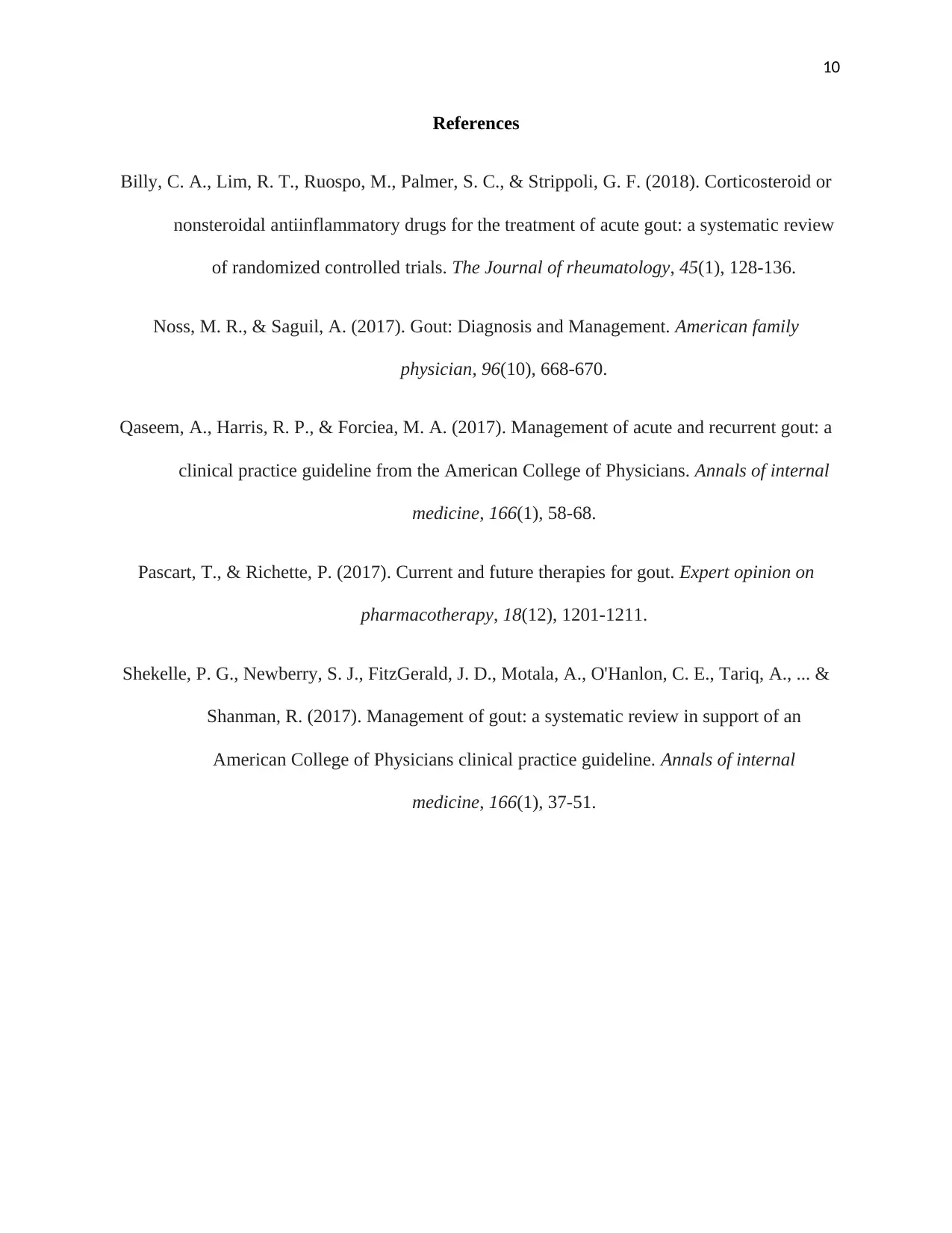
10
References
Billy, C. A., Lim, R. T., Ruospo, M., Palmer, S. C., & Strippoli, G. F. (2018). Corticosteroid or
nonsteroidal antiinflammatory drugs for the treatment of acute gout: a systematic review
of randomized controlled trials. The Journal of rheumatology, 45(1), 128-136.
Noss, M. R., & Saguil, A. (2017). Gout: Diagnosis and Management. American family
physician, 96(10), 668-670.
Qaseem, A., Harris, R. P., & Forciea, M. A. (2017). Management of acute and recurrent gout: a
clinical practice guideline from the American College of Physicians. Annals of internal
medicine, 166(1), 58-68.
Pascart, T., & Richette, P. (2017). Current and future therapies for gout. Expert opinion on
pharmacotherapy, 18(12), 1201-1211.
Shekelle, P. G., Newberry, S. J., FitzGerald, J. D., Motala, A., O'Hanlon, C. E., Tariq, A., ... &
Shanman, R. (2017). Management of gout: a systematic review in support of an
American College of Physicians clinical practice guideline. Annals of internal
medicine, 166(1), 37-51.
References
Billy, C. A., Lim, R. T., Ruospo, M., Palmer, S. C., & Strippoli, G. F. (2018). Corticosteroid or
nonsteroidal antiinflammatory drugs for the treatment of acute gout: a systematic review
of randomized controlled trials. The Journal of rheumatology, 45(1), 128-136.
Noss, M. R., & Saguil, A. (2017). Gout: Diagnosis and Management. American family
physician, 96(10), 668-670.
Qaseem, A., Harris, R. P., & Forciea, M. A. (2017). Management of acute and recurrent gout: a
clinical practice guideline from the American College of Physicians. Annals of internal
medicine, 166(1), 58-68.
Pascart, T., & Richette, P. (2017). Current and future therapies for gout. Expert opinion on
pharmacotherapy, 18(12), 1201-1211.
Shekelle, P. G., Newberry, S. J., FitzGerald, J. D., Motala, A., O'Hanlon, C. E., Tariq, A., ... &
Shanman, R. (2017). Management of gout: a systematic review in support of an
American College of Physicians clinical practice guideline. Annals of internal
medicine, 166(1), 37-51.
1 out of 10
Your All-in-One AI-Powered Toolkit for Academic Success.
+13062052269
info@desklib.com
Available 24*7 on WhatsApp / Email
![[object Object]](/_next/static/media/star-bottom.7253800d.svg)
Unlock your academic potential
Copyright © 2020–2025 A2Z Services. All Rights Reserved. Developed and managed by ZUCOL.